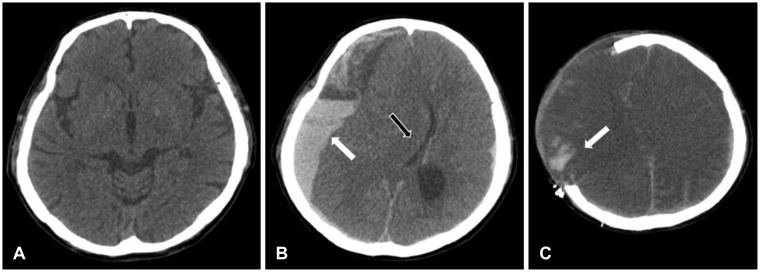1. Cosgriff TM, Lewis RM. Mechanisms of disease in hemorrhagic fever with renal syndrome. Kidney Int Suppl. 1991; 35:S72–S79. PMID:
1685203.
2. Cui N, Liu R, Lu QB, Wang LY, Qin SL, Yang ZD, et al. Severe fever with thrombocytopenia syndrome bunyavirus-related human encephalitis. J Infect. 2015; 70:52–59. PMID:
25135231.

3. Feldmann H. Truly emerging-a new disease caused by a novel virus. N Engl J Med. 2011; 364:1561–1563. PMID:
21410394.
4. Gai ZT, Zhang Y, Liang MF, Jin C, Zhang S, Zhu CB, et al. Clinical progress and risk factors for death in severe fever with thrombocytopenia syndrome patients. J Infect Dis. 2012; 206:1095–1102. PMID:
22850122.

5. Guo CT, Lu QB, Ding SJ, Hu CY, Hu JG, Wo Y, et al. Epidemiological and clinical characteristics of severe fever with thrombocytopenia syndrome (SFTS) in China: an integrated data analysis. Epidemiol Infect. 2016; 144:1345–1354. PMID:
26542444.

6. Hasegawa H, Bitoh S, Fujiwara M, Nakata M, Oku Y, Ozawa E, et al. Subdural hematoma from arterial rupture -mechanism of arterial rupture in minor head injury. No Shinkei Geka. 1982; 10:839–846. PMID:
7133304.
7. Koç RK, Paşaoğlu A, Kurtsoy A, Oktem IS, Kavuncu I. Acute spontaneous subdural hematoma of arterial origin: a report of five cases. Surg Neurol. 1997; 47:9–11. PMID:
8986157.

8. Krautkrämer E, Zeier M, Plyusnin A. Hantavirus infection: an emerging infectious disease causing acute renal failure. Kidney Int. 2013; 83:23–27. PMID:
23151954.

9. Liu S, Chai C, Wang C, Amer S, Lv H, He H, et al. Systematic review of severe fever with thrombocytopenia syndrome: virology, epidemiology, and clinical characteristics. Rev Med Virol. 2014; 24:90–102. PMID:
24310908.
10. Mettang T, Weber J, Kuhlmann U. Acute kidney failure caused by hantavirus infection. Dtsch Med Wochenschr. 1991; 116:1903–1906. PMID:
1684152.
11. Naghavi M, Wyde P, Litovsky S, Madjid M, Akhtar A, Naguib S, et al. Influenza infection exerts prominent inflammatory and thrombotic effects on the atherosclerotic plaques of apolipoprotein E-deficient mice. Circulation. 2003; 107:762–768. PMID:
12578882.

12. Najima Y, Ohashi K, Miyazawa M, Nakano M, Kobayashi T, Yamashita T, et al. Intracranial hemorrhage following allogeneic hematopoietic stem cell transplantation. Am J Hematol. 2009; 84:298–301. PMID:
19338041.

13. Yu XJ, Liang MF, Zhang SY, Liu Y, Li JD, Sun YL, et al. Fever with thrombocytopenia associated with a novel bunyavirus in China. N Engl J Med. 2011; 364:1523–1532. PMID:
21410387.
14. Zhang YZ, He YW, Dai YA, Xiong Y, Zheng H, Zhou DJ, et al. Hemorrhagic fever caused by a novel Bunyavirus in China: pathogenesis and correlates of fatal outcome. Clin Infect Dis. 2012; 54:527–533. PMID:
22144540.







 PDF
PDF ePub
ePub Citation
Citation Print
Print


 XML Download
XML Download